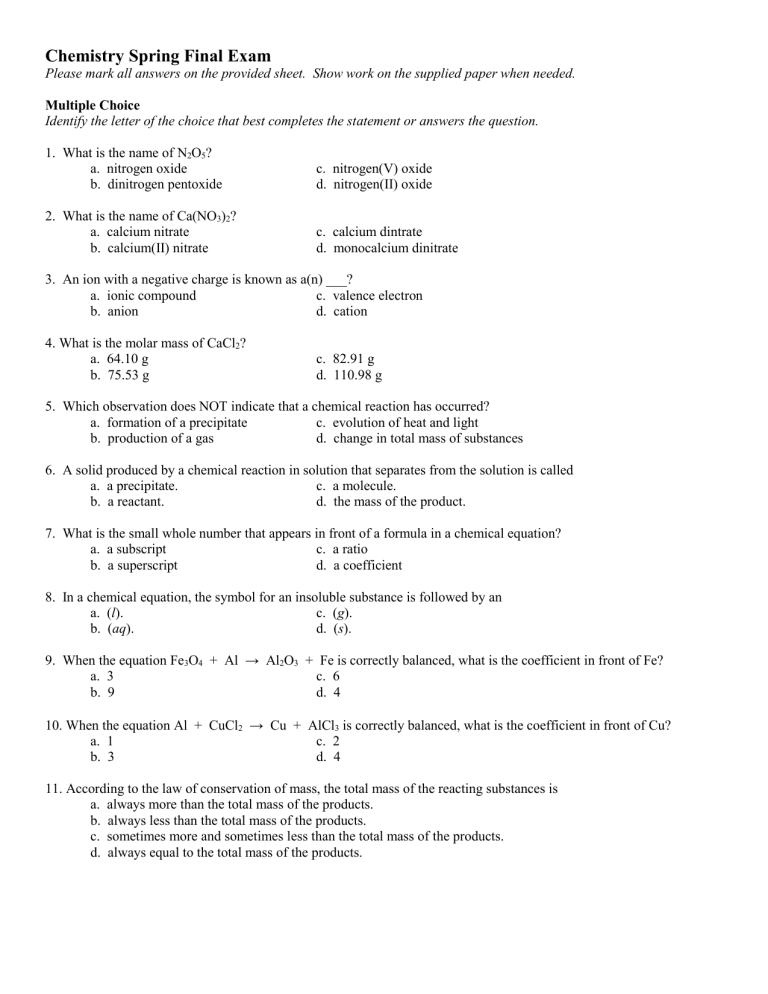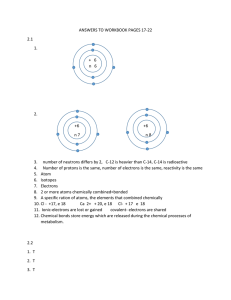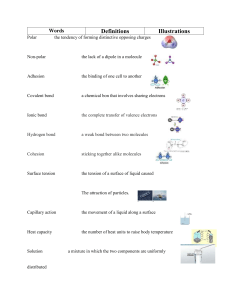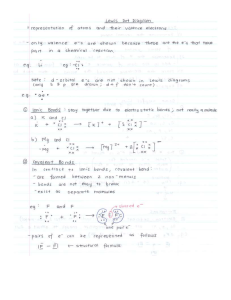
Chemistry Spring Final Exam Please mark all answers on the provided sheet. Show work on the supplied paper when needed. Multiple Choice Identify the letter of the choice that best completes the statement or answers the question. 1. What is the name of N2O5? a. nitrogen oxide b. dinitrogen pentoxide c. nitrogen(V) oxide d. nitrogen(II) oxide 2. What is the name of Ca(NO3)2? a. calcium nitrate b. calcium(II) nitrate c. calcium dintrate d. monocalcium dinitrate 3. An ion with a negative charge is known as a(n) ___? a. ionic compound c. valence electron b. anion d. cation 4. What is the molar mass of CaCl2? a. 64.10 g b. 75.53 g c. 82.91 g d. 110.98 g 5. Which observation does NOT indicate that a chemical reaction has occurred? a. formation of a precipitate c. evolution of heat and light b. production of a gas d. change in total mass of substances 6. A solid produced by a chemical reaction in solution that separates from the solution is called a. a precipitate. c. a molecule. b. a reactant. d. the mass of the product. 7. What is the small whole number that appears in front of a formula in a chemical equation? a. a subscript c. a ratio b. a superscript d. a coefficient 8. In a chemical equation, the symbol for an insoluble substance is followed by an a. (l). c. (g). b. (aq). d. (s). 9. When the equation Fe3O4 + Al → Al2O3 + Fe is correctly balanced, what is the coefficient in front of Fe? a. 3 c. 6 b. 9 d. 4 10. When the equation Al + CuCl2 → Cu + AlCl3 is correctly balanced, what is the coefficient in front of Cu? a. 1 c. 2 b. 3 d. 4 11. According to the law of conservation of mass, the total mass of the reacting substances is a. always more than the total mass of the products. b. always less than the total mass of the products. c. sometimes more and sometimes less than the total mass of the products. d. always equal to the total mass of the products. Matching Match the reaction type with the appropriate chemical reaction. a. synthesis b. double-replacement d. combustion e. single-replacement c. decomposition 12. 2KClO3(s) → 2KCl(s) + 3O2(g) 13. C5H12(g) + 8O2(g) → 5CO2(g) + 6H2O(g) 14. N2(g) + 3H2(g) → 2NH3(g) 15. 2Ag(s) + Pb(NO3)2(aq) → 2AgNO3(aq) + Pb(s) 16. CuSO4(aq) + 2AgNO3(aq) → Cu(NO3)2(aq) + Ag2SO4(s) Match the term with the appropriate definition. a. nonelectrolyte b. molarity d. dilution e. solution g. colloid h. electrolyte c. limiting reactant f. suspension 17. The concentration of a solution expressed as the moles of solute per liter of solution. 18. The maximum amount of product that can be produced from a given amount of reactant. 19. A homogeneous mixture; consists of solutes dissolved in solvent. 20. A mixture from which some of the particles settle out slowly upon standing. 21. The process of making a solution more dilute. 22. A compound that conducts an electric current when dissolved in solution or in the molten state. 23. A mixture whose particles are intermediate in size between those of a suspension and a solution. 24. A compound that does not conduct an electric current when dissolved in solution or in the molten state. Multiple Choice Identify the letter of the choice that best completes the statement or answers the question. 25. When the limiting reactant in a chemical reaction is completely used, the a. reaction stops. c reaction speeds up. b. reaction slows down. d. excess reactants begin combining. 26. Which of the following has components that are obviously different? a. homogeneous mixture c. colloid b. solution d. heterogeneous mixture 27. A substance whose water solution conducts a current is a(n) a. nonelectrolyte. c. nonpolar substance. b. electrolyte. d. solute. 28. Which of the following is a nonelectrolyte? a. sodium chloride c. carbon tetrachloride b. hydrogen chloride d. potassium chloride 29. Electrolytes affect colligative properties differently than do nonelectrolytes because electrolytes a. are volatile. b. have lower boiling points. c. produce fewer moles of solute particles per mole of solute. d. produce more moles of solute particles per mole of solute. 30. Which of the following is likely to produce crystals if disturbed? a. an unsaturated solution c. a saturated solution b. a supersaturated solution d. a concentrated solution 31. How much 12.0M HCl is needed to prepare 500.0 mL of a 3.50M HCl solution? a. 146 mL c. 1710 mL b. 0.0896 mL d. 125 mL 32. Why does a higher temperature cause a reaction to go faster? a. Collisions between molecules occur more slowly so there is more time to react. b. Collisions are not as frequent but each collision has more energy. c. Collisions occur more frequently and they occur with greater energy. d. Collisions have less energy so molecules are less likely to bounce away from one another. 33. A bond formed as a result of the transfer of electrons between atoms. a. nonpolar covalent bond. c. polar covalent bond. b. ionic bond. d. metallic bond. 34. A bond between two atoms of significantly different electronegativities resulting in the unequal sharing of electrons. a. nonpolar covalent bond. c. polar covalent bond. b. ionic bond. d. metallic bond. 35. The octet rule states that chemical compounds tend to form so that each atom has an octet of electrons in a. its highest occupied energy level. c. its d orbitals. b. the 1s orbital. d. its p orbitals. 36. What characteristic of ionic compounds makes them good electrical conductors in the molten state and when dissolved in water? a. They separate into ions in the molten state or when dissolved in water. b. They separate into neutral molecules in the molten state or when dissolved in water. c. They separate into protons and electrons in the molten state or when dissolved in water. d. Ionic compounds are not good electrical conductors. 37. What characteristic of metals makes them good electrical conductors? a. They have mobile valence electrons. b. They have mobile protons. c. They have mobile cations. d. Their crystal structures can be rearranged easily. 38. What are the strongest forces of attraction found between polar molecules? a. London dispersion c. hydrogen bonding b. dipole-dipole d. ion-dipole 39. Which force of attraction is the weakest? a. London dispersion b. dipole-dipole c. hydrogen bonding d. ion-dipole 40. What video game does Mr Crayton spend most of his time playing with his wife? a. FORTNITE c. quake b. doom d. elmo’s thunder baseball






